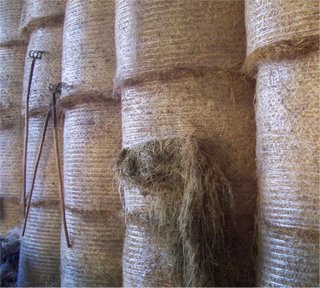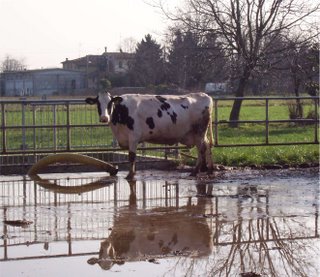Where the milk comes from
So today's trip was to the dairy farm:
we got in the bus
to go to the farm
to meet the man
who owns the cows
who give the milk
that makes the cheese...

But before the farm, there was the Christmas market, and a stall selling small round edibles of a Sicilian persuasion.
Then there was the farm. More round things.

In addition to a persimmon tree, they had 200 cows, about half of which are giving milk at any time while the others are either growing up or getting ready to give birth. This farm had only Friesians, which came from Canada and the U.S. The farmer belonged to a dairy co-op of 11 farms and was very near his cheese factory, convenient for making that 2 hour deadline to deliver the milk. The other restriction on milking for Parmigiano-Reggiano is that the actual milking must be completed within four hours, start to finish (this farm managed it in one and a half hours, twice a day).

Hmm... these remind me of something I've seen lately... cylindrical, straw-coloured, stacked to the ceiling... The Parmigiano-Reggiano consortium obliges its dairy farms to produce - on-site - at least 50% of the feed for their cattle; this farm produces 90% of its feed. No animal products can be included in the diet of the dairy cattle, and no silage or wet grass, all to preserve the safety of the cheese, the reliability of the ripening process, and the purity of the flavour.

My fellow Canadian?

We observed the bedroom of the cows.

Scary farm dog.

And on that farm there was a cow...

Why yes, as a matter of fact, I was born yesterday.
we got in the bus
to go to the farm
to meet the man
who owns the cows
who give the milk
that makes the cheese...

But before the farm, there was the Christmas market, and a stall selling small round edibles of a Sicilian persuasion.
Then there was the farm. More round things.

In addition to a persimmon tree, they had 200 cows, about half of which are giving milk at any time while the others are either growing up or getting ready to give birth. This farm had only Friesians, which came from Canada and the U.S. The farmer belonged to a dairy co-op of 11 farms and was very near his cheese factory, convenient for making that 2 hour deadline to deliver the milk. The other restriction on milking for Parmigiano-Reggiano is that the actual milking must be completed within four hours, start to finish (this farm managed it in one and a half hours, twice a day).

Hmm... these remind me of something I've seen lately... cylindrical, straw-coloured, stacked to the ceiling... The Parmigiano-Reggiano consortium obliges its dairy farms to produce - on-site - at least 50% of the feed for their cattle; this farm produces 90% of its feed. No animal products can be included in the diet of the dairy cattle, and no silage or wet grass, all to preserve the safety of the cheese, the reliability of the ripening process, and the purity of the flavour.

My fellow Canadian?

We observed the bedroom of the cows.

Scary farm dog.

And on that farm there was a cow...

Why yes, as a matter of fact, I was born yesterday.



3 Comments:
I love the cow photos! Did you see any dancing in tutus?
I understand that Friesians only dance in tutus after the evening milking, and we couldn't stay for that. I am not sure about other breeds.
Yes they are lovely happy-looking cows, and I had no idea that cheese making was such an ordeal. i finally found some Danish Gjetosk that i have been nibbling at with my daily apple.
Post a Comment
<< Home